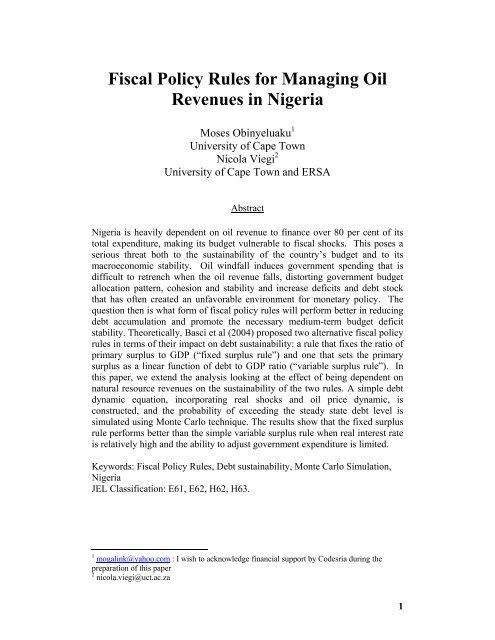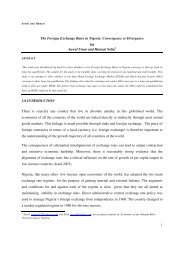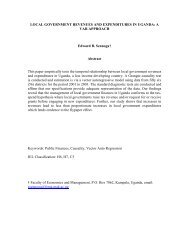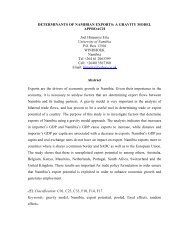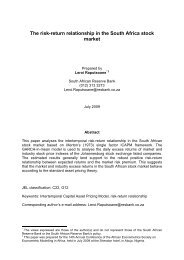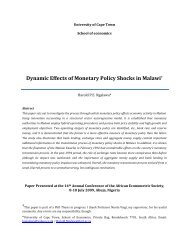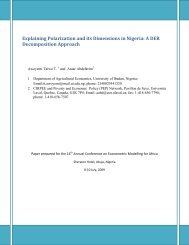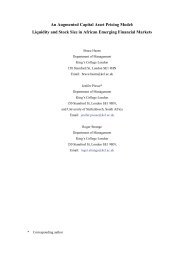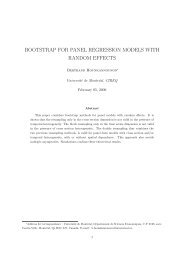Fiscal policy rules for managing oil revenues in Nigeria
Fiscal policy rules for managing oil revenues in Nigeria
Fiscal policy rules for managing oil revenues in Nigeria
Create successful ePaper yourself
Turn your PDF publications into a flip-book with our unique Google optimized e-Paper software.
<strong>Fiscal</strong> Policy Rules <strong>for</strong> Manag<strong>in</strong>g Oil<br />
Revenues <strong>in</strong> <strong>Nigeria</strong><br />
Moses Ob<strong>in</strong>yeluaku 1<br />
University of Cape Town<br />
Nicola Viegi 2<br />
University of Cape Town and ERSA<br />
Abstract<br />
<strong>Nigeria</strong> is heavily dependent on <strong>oil</strong> revenue to f<strong>in</strong>ance over 80 per cent of its<br />
total expenditure, mak<strong>in</strong>g its budget vulnerable to fiscal shocks. This poses a<br />
serious threat both to the susta<strong>in</strong>ability of the country’s budget and to its<br />
macroeconomic stability. Oil w<strong>in</strong>dfall <strong>in</strong>duces government spend<strong>in</strong>g that is<br />
difficult to retrench when the <strong>oil</strong> revenue falls, distort<strong>in</strong>g government budget<br />
allocation pattern, cohesion and stability and <strong>in</strong>crease deficits and debt stock<br />
that has often created an unfavorable environment <strong>for</strong> monetary <strong>policy</strong>. The<br />
question then is what <strong>for</strong>m of fiscal <strong>policy</strong> <strong>rules</strong> will per<strong>for</strong>m better <strong>in</strong> reduc<strong>in</strong>g<br />
debt accumulation and promote the necessary medium-term budget deficit<br />
stability. Theoretically, Basci et al (2004) proposed two alternative fiscal <strong>policy</strong><br />
<strong>rules</strong> <strong>in</strong> terms of their impact on debt susta<strong>in</strong>ability: a rule that fixes the ratio of<br />
primary surplus to GDP (“fixed surplus rule”) and one that sets the primary<br />
surplus as a l<strong>in</strong>ear function of debt to GDP ratio (“variable surplus rule”). In<br />
this paper, we extend the analysis look<strong>in</strong>g at the effect of be<strong>in</strong>g dependent on<br />
natural resource <strong>revenues</strong> on the susta<strong>in</strong>ability of the two <strong>rules</strong>. A simple debt<br />
dynamic equation, <strong>in</strong>corporat<strong>in</strong>g real shocks and <strong>oil</strong> price dynamic, is<br />
constructed, and the probability of exceed<strong>in</strong>g the steady state debt level is<br />
simulated us<strong>in</strong>g Monte Carlo technique. The results show that the fixed surplus<br />
rule per<strong>for</strong>ms better than the simple variable surplus rule when real <strong>in</strong>terest rate<br />
is relatively high and the ability to adjust government expenditure is limited.<br />
Keywords: <strong>Fiscal</strong> Policy Rules, Debt susta<strong>in</strong>ability, Monte Carlo Simulation,<br />
<strong>Nigeria</strong><br />
JEL Classification: E61, E62, H62, H63.<br />
1 mogal<strong>in</strong>k@yahoo.com : I wish to acknowledge f<strong>in</strong>ancial support by Codesria dur<strong>in</strong>g the<br />
preparation of this paper<br />
2 nicola.viegi@uct.ac.za<br />
1
1. INTRODUCTION<br />
Macroeconomic dynamic <strong>in</strong> <strong>Nigeria</strong> has been dom<strong>in</strong>ated <strong>in</strong> the past by fiscal<br />
<strong>in</strong>stability. There have been a strong deficit and debt bias stemm<strong>in</strong>g from<br />
government revenue volatility. As a result, monetary authority has been <strong>for</strong>ced<br />
to implement neutraliz<strong>in</strong>g monetary policies lead<strong>in</strong>g to macroeconomic<br />
<strong>in</strong>stability. 3<br />
Policies adopted <strong>in</strong> response to high debt levels among the emerg<strong>in</strong>g and<br />
developed countries vary. Brazil and Turkey have used the fixed primary<br />
surplus rule, which fixes the ratio of primary budget surplus to GDP (Basci et<br />
al, 2004). Argent<strong>in</strong>a and Peru have applied limits to the overall balance and<br />
primary expenditure. New Zealand has <strong>rules</strong> <strong>for</strong> the operat<strong>in</strong>g balance as well<br />
as debt limits. 4 There is also the Stability and Growth Pact <strong>in</strong> the European<br />
Union, though the issue of flexibility is beg<strong>in</strong>n<strong>in</strong>g to appear <strong>in</strong> the practical<br />
application of the constra<strong>in</strong>ts. 5<br />
Draw<strong>in</strong>g on this literature, the paper illustrates the appropriate fiscal <strong>policy</strong><br />
<strong>rules</strong> that will per<strong>for</strong>m better <strong>in</strong> reduc<strong>in</strong>g debt accumulation and promote the<br />
necessary medium-term budget deficit stability <strong>in</strong> <strong>Nigeria</strong>. It <strong>in</strong>tends to<br />
supplement a similar work by Baunsgaard (2003). 6<br />
The paper compares the per<strong>for</strong>mance of the fixed primary surplus rule to an<br />
alternative, the variable primary surplus rule, under which the primary budget<br />
surplus is explicitly def<strong>in</strong>ed as an <strong>in</strong>creas<strong>in</strong>g function of the debt-to-GDP ratio,<br />
us<strong>in</strong>g Monte Carlo technique. However, s<strong>in</strong>ce government revenue <strong>in</strong> <strong>Nigeria</strong><br />
is exogenously given, the paper deviates a bit from the exist<strong>in</strong>g literature by<br />
decompos<strong>in</strong>g the primary surpluses <strong>in</strong>to gross budgetary revenue and non-<br />
3 See Bat<strong>in</strong>i (2004) and Ob<strong>in</strong>yeluaku (2006)<br />
4 See Kopits and Symansky (1998) and Kopits (2001).<br />
5 See Dixit and Lambert<strong>in</strong>i (2003) <strong>for</strong> more details.<br />
6 He designed a fiscal rule nested with<strong>in</strong> the long-run susta<strong>in</strong>able use of <strong>oil</strong> revenue <strong>in</strong> <strong>Nigeria</strong>.<br />
2
<strong>in</strong>terest budgetary expenditure <strong>in</strong> order to capture not only the volatility <strong>in</strong><br />
revenue via <strong>oil</strong> price dynamic, but also to control <strong>for</strong> the government<br />
expenditure. 7 At least, <strong>for</strong> any fixed (variable) primary surplus rule, there is also<br />
the level of fixed (variable) budgetary expenditure necessary to ma<strong>in</strong>ta<strong>in</strong> such<br />
rule. Shocks to real economy and <strong>oil</strong> prices are <strong>in</strong>corporated <strong>in</strong> the model. 8 As<br />
the criterion of comparison, we use the probability of exceed<strong>in</strong>g the susta<strong>in</strong>able<br />
debt level at the end of the simulation horizon start<strong>in</strong>g from a given <strong>in</strong>itial debt<br />
level.<br />
The results show that <strong>in</strong> general the variable surplus rule per<strong>for</strong>ms better than<br />
the simple fixed surplus rule, by reduc<strong>in</strong>g debt accumulation and the necessary<br />
medium-term primary surplus. On the other hand a fix surplus rule works better<br />
when the real <strong>in</strong>terest rate is relatively high, i.e. when the explosive behavior of<br />
debt dynamic is especially pronounced: With both <strong>rules</strong> fiscal stability implies a<br />
marked <strong>in</strong>crease <strong>in</strong> expenditure variability, more pronounce <strong>for</strong> the variable<br />
<strong>in</strong>terest rule. This result suggests that the government’s ability to make a<br />
credible commitment to a fiscal rule depends on the flexibility of fiscal<br />
expenditure.<br />
The paper is organized as follows. Section II provides a brief overview of past<br />
fiscal <strong>policy</strong> <strong>in</strong> <strong>Nigeria</strong>. Section III develops the model, and the analytical<br />
def<strong>in</strong>itions of the two fiscal <strong>rules</strong> and debt susta<strong>in</strong>ability. The results of the<br />
numerical simulations are presented <strong>in</strong> section IV and V. Section VI concludes.<br />
II THE FISCAL STANCE<br />
The past two decades have witnessed a considerable <strong>in</strong>crease <strong>in</strong> government<br />
<strong>in</strong>debtedness <strong>in</strong> <strong>Nigeria</strong>. Beyond the issue of poor quality of public<br />
7 <strong>Fiscal</strong> <strong>policy</strong> <strong>rules</strong> could play a role <strong>in</strong> stabiliz<strong>in</strong>g expenditure programs at level consistent<br />
with the necessary medium-term deficit stability.<br />
8 A fiscal rule target<strong>in</strong>g a certa<strong>in</strong> overall or primary fiscal balance <strong>in</strong> <strong>Nigeria</strong> without tak<strong>in</strong>g <strong>in</strong>to<br />
account, <strong>oil</strong> revenue volatility, will not prevent procyclical fiscal policies (Baunsgaard, 2003).<br />
3
expenditure, the ability to save w<strong>in</strong>dfalls from excess crude <strong>oil</strong> proceeds by the<br />
government rema<strong>in</strong>s critical <strong>in</strong> ensur<strong>in</strong>g that government expenditure is<br />
ma<strong>in</strong>ta<strong>in</strong>ed at a susta<strong>in</strong>able level and consistent with the absorptive capacity of<br />
the economy.<br />
Figure 1a reveals that there is a substantial <strong>in</strong>crease <strong>in</strong> government spend<strong>in</strong>g,<br />
primary deficit and debt <strong>in</strong> <strong>Nigeria</strong> between 1980 and 2005. The <strong>oil</strong> w<strong>in</strong>dfall<br />
between 1990 and 1992 was followed by rapid growth <strong>in</strong> government spend<strong>in</strong>g<br />
with an average of about 21 percent of GDP dur<strong>in</strong>g that period. However, as the<br />
<strong>oil</strong> market weakened <strong>in</strong> the subsequent years, <strong>oil</strong> receipts were not adequate to<br />
meet <strong>in</strong>creas<strong>in</strong>g levels of demands, and expenditures be<strong>in</strong>g re<strong>in</strong><strong>for</strong>ced by<br />
political pressures, were not rationalised. Government resorted to borrow<strong>in</strong>g<br />
ma<strong>in</strong>ly from the central bank to f<strong>in</strong>ance the huge deficits (see figure 1b).<br />
From figure 1b, the CBN absorbs almost half of the <strong>Nigeria</strong>n public debt<br />
follow<strong>in</strong>g Commercial bank and the public. This implies that government is<br />
ma<strong>in</strong>ly f<strong>in</strong>anc<strong>in</strong>g its huge deficits through seigniorage − the so called “fiscal<br />
<strong>in</strong>discipl<strong>in</strong>e.” And when government pr<strong>in</strong>ts money (or use seigniorage), it<br />
<strong>in</strong>creases the money supply and this <strong>in</strong> turn causes <strong>in</strong>flation.<br />
Although the democratically elected government <strong>in</strong> 1999 adopted policies to<br />
restore fiscal discipl<strong>in</strong>e, the rapid monetization of <strong>for</strong>eign exchange earn<strong>in</strong>gs<br />
between 2000 and 2004, another era of <strong>oil</strong> w<strong>in</strong>dfall, resulted <strong>in</strong> a large <strong>in</strong>creases<br />
<strong>in</strong> government spend<strong>in</strong>g. In 2005 alone, government spend<strong>in</strong>g <strong>in</strong>creases to 19<br />
percent of GDP from 14 percent <strong>in</strong> 2000. Extra budgetary outlays not <strong>in</strong>itially<br />
<strong>in</strong>cluded <strong>in</strong> the budget <strong>in</strong>creased. Worst till, most of this spend<strong>in</strong>g are not<br />
directed towards capital and socio-economic sectors.<br />
Corollary, primary deficit worsened from an average of 2.6 percent of GDP <strong>in</strong><br />
1980s to one of 6.2 percent <strong>in</strong> 1990s. In 2002 alone, primary deficit <strong>in</strong>creases<br />
to 5 percent of GDP from 2 percent <strong>in</strong> 2000. This <strong>in</strong>crease <strong>in</strong> deficits results <strong>in</strong><br />
4
a mount<strong>in</strong>g stock of debt, rang<strong>in</strong>g from 88 percent of GDP <strong>in</strong> 1980s to 96<br />
percent of GDP <strong>in</strong> 1990s. In 2002 alone, the shock of debt <strong>in</strong>creases to 91 per<br />
cent of GDP from 45 per cent <strong>in</strong> 2000. However, consider<strong>in</strong>g the uncerta<strong>in</strong><br />
fiscal dynamics <strong>in</strong> <strong>Nigeria</strong>, the recent fiscal adjustment witnessed <strong>in</strong> 2005 might<br />
still not be susta<strong>in</strong>ed.<br />
<strong>Nigeria</strong>’s fiscal <strong>revenues</strong> are largely co<strong>in</strong>cided with <strong>oil</strong> revenue account<strong>in</strong>g <strong>for</strong><br />
nearly 80 percent of government <strong>revenues</strong>, which implies that the economy is<br />
highly exposed to price fluctuations <strong>in</strong> the world <strong>oil</strong> markets. Naturally, <strong>oil</strong><br />
revenue is very volatile due to world oscillation <strong>in</strong> <strong>oil</strong> prices and to<br />
unpredictable changes <strong>in</strong> OPEC assigned <strong>oil</strong> quota − of which <strong>Nigeria</strong> has been<br />
a member s<strong>in</strong>ce 1958 follow<strong>in</strong>g the commercial discovery of <strong>oil</strong> <strong>in</strong> Ofoibiri <strong>in</strong><br />
River State, <strong>Nigeria</strong> <strong>in</strong> 1956.<br />
Absent suitable fiscal <strong>rules</strong> and a proper f<strong>in</strong>ance-management framework <strong>for</strong> <strong>oil</strong><br />
related risks over the past two decade <strong>in</strong> <strong>Nigeria</strong> have led to boom-and-busttype<br />
fiscal policies that have generated large and unpredictable movements <strong>in</strong><br />
government f<strong>in</strong>ances. 9 Consequently, this has been a recurrent source of<br />
destabiliz<strong>in</strong>g effect of fiscal surprises on the domestic prices and exchange rate<br />
as well as f<strong>in</strong>ancial system. 10<br />
9 Also see Katz (2003)<br />
10 See Welcome Address by the <strong>for</strong>mer CBN Governor, Dr. J. Sanusi on 2004 Federal<br />
Government Budget, and an Address by the New CBN Governor, Prof. C.C. Soludo, on the<br />
Bankers’ Committee Meet<strong>in</strong>g, July 2004).<br />
5
Figure 1<br />
(a) <strong>Nigeria</strong> <strong>Fiscal</strong> Trends, 1980-2005 (% of GDP)<br />
(b) Hold<strong>in</strong>gs of the <strong>Nigeria</strong>’s Governments Domestic Debt by the Central<br />
Bank, Commercial Bank and Public (Percentage of GDP<br />
30.0<br />
25.0<br />
20.0<br />
15.0<br />
10.0<br />
5.0<br />
0.0<br />
-5.0<br />
1980<br />
1981<br />
1982<br />
1983<br />
1984<br />
1985<br />
1986<br />
1987<br />
1988<br />
1989<br />
1990<br />
1991<br />
1992<br />
1993<br />
1994<br />
1995<br />
1996<br />
1997<br />
1998<br />
1999<br />
2000<br />
2001<br />
2002<br />
2003<br />
2004<br />
2005<br />
cbn comercial public<br />
6
III FISCAL RULES WITH UNCERTAIN REVENUES<br />
There is an abundant academic literature on why unconstra<strong>in</strong>ed discretion over<br />
fiscal <strong>policy</strong> can erode public f<strong>in</strong>ances and create unfavourable environment <strong>for</strong><br />
monetary <strong>policy</strong> and macroeconomic stability. The bottom l<strong>in</strong>e is that there is<br />
generally a strong pressure on expand<strong>in</strong>g government expenditure, a reluctance<br />
to raise taxes to the extent necessary to fully f<strong>in</strong>ance public undertak<strong>in</strong>gs (often<br />
referred to as fiscal illusion and a deficit bias) and the possibility of an <strong>in</strong>flation<br />
bias.<br />
As monetary <strong>policy</strong> rule <strong>in</strong>tend to limit the ability of monetary authority to act<br />
discretionally, so fiscal <strong>policy</strong> <strong>rules</strong> will – if observed – mitigate the<br />
government’s tendency to abandon previous <strong>policy</strong> commitment. They seek to<br />
confer credibility on the conduct of macroeconomic policies by remov<strong>in</strong>g<br />
discretionary <strong>in</strong>terventions. Their goal is to achieve trust by guarantee<strong>in</strong>g that<br />
fundamentals will rema<strong>in</strong> predictable and robust regardless of the government<br />
<strong>in</strong> power. Thus, fiscal <strong>policy</strong> <strong>rules</strong> are particularly helpful if the government is<br />
not able to guarantee a prudent fiscal <strong>policy</strong> to the economic sectors. It thus<br />
seems appropriate to study the susta<strong>in</strong>ability of simple fiscal <strong>rules</strong> <strong>in</strong> a case like<br />
<strong>Nigeria</strong>, where the first source of macroeconomic <strong>in</strong>stability is certa<strong>in</strong>ly the<br />
dynamic of fiscal <strong>policy</strong>.<br />
A. FISCAL POLICY WITH STOCHASTIC REVENUES<br />
The possible way to model fiscal <strong>policy</strong> <strong>in</strong> <strong>Nigeria</strong> is to consider the stochastic<br />
nature of government <strong>revenues</strong> that we have illustrated <strong>in</strong> the previous section.<br />
S<strong>in</strong>ce about 80 percent of government <strong>revenues</strong> come from <strong>oil</strong>, we can safely<br />
assume that total gross budgetary <strong>revenues</strong> equal to<br />
GR<br />
t<br />
⎛<br />
Pt<br />
Q − ⎞<br />
t<br />
=<br />
⎜ ⎝ ⎠<br />
⎟ . (1) 7
Where<br />
Q −<br />
is the quantity of <strong>oil</strong>,, assumed to be fixed,<br />
t<br />
11 and P t is its price.<br />
Thus, primary surplus at the end of the budget year is equal to:<br />
−<br />
⎛ ⎞<br />
PSt = Pt⎜Q t⎟−Gt ⎝ ⎠<br />
(2)<br />
The government <strong>in</strong> each year has to plan expenditure G t on the basis of a<br />
<strong>for</strong>ecast of <strong>oil</strong> <strong>revenues</strong> <strong>for</strong> the period. If we assume that the price of <strong>oil</strong> follow<br />
a pure random walk,<br />
P = P −1<br />
+ v , as our unit root test results shows, this<br />
t<br />
t<br />
implies that the best <strong>for</strong>ecast of <strong>oil</strong> price is equal to so E t<br />
( P t<br />
) = P t −1<br />
this, the expected primary surplus at the beg<strong>in</strong>n<strong>in</strong>g of budget year is;<br />
t<br />
. Follow<strong>in</strong>g<br />
−<br />
⎛ ⎞<br />
=<br />
⎜ t ⎟<br />
)<br />
⎝ ⎠<br />
( PS t<br />
) E t<br />
⎜ P ⎟<br />
−1<br />
− E t<br />
( G t<br />
E t −1 Q −1<br />
(3)<br />
or,<br />
−<br />
⎛ ⎞<br />
Et<br />
−1( PSt<br />
) = P ⎜<br />
t 1 Q ⎟<br />
−<br />
− Et<br />
1( Gt<br />
),<br />
t<br />
−<br />
(3b)<br />
⎝ ⎠<br />
The <strong>in</strong>ability to control fiscal <strong>revenues</strong> <strong>in</strong>troduce a significant element of<br />
uncerta<strong>in</strong>ty <strong>in</strong> the budgetary process, equal to the volatility of <strong>oil</strong> prices v t . Any<br />
fiscal rule, <strong>in</strong> this context, should be tested us<strong>in</strong>g the budgetary process<br />
described by equation (3).<br />
Once government expenditure decision and <strong>oil</strong> prices are determ<strong>in</strong>ed, the<br />
result<strong>in</strong>g primary surplus will give the follow<strong>in</strong>g debt dynamic.<br />
11 Be<strong>in</strong>g exogenous and determ<strong>in</strong>ed by OPEC not the government.<br />
8
= + 1 ( 1 + )( − ) t<br />
D R D PS , (4)<br />
t t t<br />
where, R t is the real <strong>in</strong>terest rate <strong>in</strong> period t and D t is the debt stock at the<br />
beg<strong>in</strong>n<strong>in</strong>g of the period t. Both PS t and D t are <strong>in</strong> real terms. To express (4) <strong>in</strong><br />
term of output ratio we assume a constant growth rate of output. The path of<br />
real output is then given by<br />
( t<br />
) Y t<br />
Y t + 1<br />
= 1+ g , (5)<br />
where g t is the constant growth rate. Def<strong>in</strong><strong>in</strong>g, the debt to GDP ratio as d t = D t /<br />
Y t and comb<strong>in</strong><strong>in</strong>g (4) and (5),<br />
⎣( ) ( ) ⎦ ( ps t )<br />
dt+ 1<br />
= ⎡ 1+ rt 1+ gt ⎤ dt<br />
−<br />
, (6)<br />
where ps t =PS t / Y t .<br />
To facilitate the comparison of our results with the one <strong>in</strong> Basci et al (2004), we<br />
ma<strong>in</strong>ta<strong>in</strong> the assumption that R t and g t have random components. We there<strong>for</strong>e<br />
can def<strong>in</strong>e the random variable r t<br />
through the follow<strong>in</strong>g decomposition:<br />
+ ε , the growth adjusted real <strong>in</strong>terest rate,<br />
t<br />
t<br />
t<br />
( 1+<br />
Rt<br />
)<br />
( 1+<br />
g )<br />
1+<br />
r + ε = , (7)<br />
t<br />
where r t is the determ<strong>in</strong>istic component of the real growth adjusted <strong>in</strong>terest rate,<br />
and є t is a zero mean <strong>in</strong>dependently and identically distributed (iid) random<br />
variable which represents the <strong>in</strong>terest rate, and growth shocks.<br />
9
Next, assume that the determ<strong>in</strong>istic component of the growth adjusted mean<br />
real <strong>in</strong>terest rate r(d t ) is an <strong>in</strong>creas<strong>in</strong>g function of the debt to GDP ratio. 12<br />
t<br />
( d t<br />
r = r ) with r ’ (d t )>0, (8)<br />
where r ’ (d t ) represents the first derivative of r(d t )<br />
Comb<strong>in</strong><strong>in</strong>g (6), (7) and (8), we obta<strong>in</strong>,<br />
d<br />
( 1+<br />
r( d<br />
t<br />
) +<br />
t<br />
)( dt<br />
− pst<br />
)<br />
1<br />
=<br />
, (9)<br />
t+ ε<br />
where d t denotes debt to GDP ratio at the beg<strong>in</strong>n<strong>in</strong>g of period t, and ps t denotes<br />
the ratio of primary surplus to GDP <strong>in</strong> period t. It is assume that growth<br />
adjusted mean real <strong>in</strong>terest rate, r(d t ) is an <strong>in</strong>creas<strong>in</strong>g function of the debt to<br />
GDP ratio.<br />
S<strong>in</strong>ce the analysis here is limited to a develop<strong>in</strong>g country, like <strong>Nigeria</strong>, a l<strong>in</strong>ear<br />
function of debt stock is assumed, <strong>for</strong> simplicity. 13<br />
r<br />
( d t<br />
) ρdt<br />
= For all t, (10)<br />
where 0 < ρ
and comb<strong>in</strong><strong>in</strong>g (9), (10) and (11) we obta<strong>in</strong><br />
2<br />
c<br />
ρ d − ρd<br />
ps − ps ,<br />
(12)<br />
c<br />
t<br />
t<br />
B. FISCAL POLICY RULES<br />
As <strong>in</strong> the Basci et al (2004), two alternative <strong>policy</strong> <strong>rules</strong> are considered:<br />
(1) Fixed Primary Surplus Rule<br />
The fixed primary surplus rule is equal to a constant s percent of GDP at every<br />
period: ps t = s <strong>for</strong> all t, and <strong>in</strong> our case is<br />
ps<br />
t<br />
= s = P<br />
⎛<br />
⎝<br />
⎞<br />
⎠<br />
−<br />
t −1 ⎜Qt<br />
⎟ − Gt<br />
, (13)<br />
Now by controll<strong>in</strong>g <strong>for</strong> G t , 15 our fixed expenditure rule now becomes<br />
G<br />
t<br />
−<br />
⎡ ⎛ ⎞⎤<br />
= ⎢Pt<br />
−1 ⎜Qt<br />
⎟⎥<br />
− s , (14)<br />
⎣ ⎝ ⎠⎦<br />
and fixed primary surplus rule, revenue at time t (GR t ) m<strong>in</strong>us fixed<br />
expenditure rule (which is G t ). Equation (14) is the level of expenditure<br />
necessary <strong>in</strong> order to ma<strong>in</strong>ta<strong>in</strong> a fixed primary surplus rule. The Critical debt<br />
level <strong>for</strong> the fixed primary surplus rule 16 is the value of debt that solve the<br />
follow<strong>in</strong>g quadratic equation;<br />
2<br />
c<br />
ρ d − sρd<br />
− s = 0 , (15)<br />
c<br />
15 We cannot control <strong>for</strong> P t (Q t ) due to <strong>oil</strong> price volatility.<br />
16 Obta<strong>in</strong>ed by tak<strong>in</strong>g ps t = s <strong>in</strong>to (12)<br />
11
which can be calculated as,<br />
⎛<br />
2<br />
ρ ( ρ ) 4 ρ ⎞<br />
⎜ s + ⎜ ⎛ s + s ⎟⎞<br />
⎟<br />
⎝ ⎝<br />
⎠<br />
d =<br />
⎠<br />
c<br />
, (16)<br />
2ρ<br />
2 +<br />
as s, ρ > 0 so that sρ<br />
( sρ<br />
) 4sρ<br />
< .<br />
:<br />
(2) Variable Primary Surplus Rule<br />
A variable fiscal rule adjusts the expected level of fiscal surpluses to the<br />
outstand<strong>in</strong>g level of debt so that a higher fiscal surplus (a tighter fiscal <strong>policy</strong>)<br />
is set as the debt stock <strong>in</strong>creases: a simple l<strong>in</strong>ear expression of that could be<br />
ps<br />
= σ <strong>for</strong> all t, σ > 0.<br />
t<br />
d t<br />
Substitut<strong>in</strong>g σd t <strong>for</strong> s <strong>in</strong> (14), then; our variable expenditure rule will look<br />
like;<br />
G<br />
t<br />
−<br />
⎡ ⎛ ⎞⎤<br />
= ⎢Pt<br />
−1 ⎜Qt<br />
⎟⎥<br />
−σdt<br />
, (17)<br />
⎣ ⎝ ⎠⎦<br />
and variable primary surplus rule, revenue at time t m<strong>in</strong>us variable<br />
expenditure <strong>rules</strong>. Aga<strong>in</strong>, (17) is the level of expenditure necessary <strong>in</strong> order to<br />
ma<strong>in</strong>ta<strong>in</strong> a variable primary surplus rule.<br />
With this rule the Critical debt level 17 is:<br />
'<br />
c<br />
( − σ )<br />
d = σ ρ 1<br />
(18)<br />
17 Aga<strong>in</strong>, obta<strong>in</strong>ed by tak<strong>in</strong>g ps t = σd t <strong>in</strong>to (12)<br />
12
When d t > d c , debt level blows up, and it tends to decl<strong>in</strong>e when d t < d c under<br />
both fiscal <strong>rules</strong>. 18<br />
Note that which one of the two <strong>rules</strong> is more str<strong>in</strong>gent depends critically on the<br />
level of sensitivity of real <strong>in</strong>terest rate to the level of debt ρ. As we can see from<br />
the follow<strong>in</strong>g numerical representation of the two functions (with parameters<br />
values equal to the one used <strong>in</strong> the simulations that follows), <strong>for</strong> low level of ρ<br />
(and consequently low level of real <strong>in</strong>terest rate at any level of debt), a variable<br />
fiscal rule offers a much less str<strong>in</strong>gent constra<strong>in</strong>t to the <strong>policy</strong> maker. The<br />
opposite is true at the opposite end of ρ range, where is now the fix fiscal rule<br />
that is a less str<strong>in</strong>gent rule. This is somehow paradoxical: the variable rule, with<br />
a built <strong>in</strong> adjustment mechanism, should by def<strong>in</strong>ition give more room of<br />
manoeuvre to the <strong>policy</strong> maker. At the same time high <strong>in</strong>terest rate penalizes<br />
very significantly any <strong>in</strong>crease <strong>in</strong> debt level so that the feedback mechanism <strong>in</strong><br />
the variable rule might not be fast enough to respond to a change <strong>in</strong> direction of<br />
the debt dynamics. This is not quite <strong>in</strong>tuitive and the simulations will help <strong>in</strong><br />
expla<strong>in</strong><strong>in</strong>g this paradox.<br />
18 As already proved <strong>in</strong> Basci et al (2004).<br />
13
Figure 2 : Critical Level of Debt and Sensitivity of Real Interest Rate to Debt<br />
Stock<br />
IV SIMULATION RESULTS<br />
The model illustrated <strong>in</strong> the previous sections is used to conduct simulations <strong>for</strong><br />
both fiscal <strong>rules</strong> us<strong>in</strong>g Monte Carlo techniques, <strong>for</strong> <strong>in</strong>itial debt ratios (d 0 )<br />
rang<strong>in</strong>g from 20 percent of GDP to 100 percent of GDP. To per<strong>for</strong>m the<br />
simulations we calibrate <strong>in</strong>itial <strong>oil</strong> price level so that the government <strong>revenues</strong><br />
at the beg<strong>in</strong>n<strong>in</strong>g of the simulation amount to 20 percent of GDP, which is the<br />
average government revenue <strong>in</strong> <strong>Nigeria</strong> <strong>for</strong> the past 10 years. The two shocks <strong>in</strong><br />
the model, <strong>oil</strong> shock v t and real rate shock є t , are assumed to be normally<br />
distributed with zero mean and 2.5 percent variance and 5 percent respectively.<br />
The debt ratio is than calculated us<strong>in</strong>g equation (9); and 1000 replications of a<br />
14
five year horizon debt dynamic are computed. Arithmetic averages and standard<br />
deviations of these trials are used <strong>in</strong> the quantitative analysis.<br />
In other to capture the sensitivity of both <strong>rules</strong> to real <strong>in</strong>terest rate levels, the<br />
simulations are conducted with ρ at 10 percent and 15 percent, so that with a<br />
basel<strong>in</strong>e debt to GDP ratio of 60 percent, the growth adjusted real <strong>in</strong>terest rate<br />
is 6 percent (low) and 9 percent (high) respectevely.<br />
For the numerical simulations, we set the parameters <strong>for</strong> both fiscal <strong>policy</strong> <strong>rules</strong><br />
as follows:<br />
Fixed Rule:<br />
⎡ ⎛<br />
Gt Pt 1<br />
Q − ⎞⎤<br />
= ⎢ − ⎜ t⎟<br />
⎝ ⎠<br />
⎥− s , s = 0.04 correspond<strong>in</strong>g to d c = 0.6528<br />
⎣ ⎦<br />
Variable Rule:<br />
G<br />
t<br />
−<br />
⎡ ⎛ ⎞⎤<br />
= ⎢Pt<br />
−1 ⎜Qt<br />
⎟⎥<br />
−σdt<br />
, σ = 0.0667, correspond<strong>in</strong>g to d ’ c = 0.7143<br />
⎣ ⎝ ⎠⎦<br />
The ma<strong>in</strong> result of the simulation is shown <strong>in</strong> table 1. Start<strong>in</strong>g with a 60% level<br />
of debt to gdp ratio and with ρ=0.1, the variable rule m<strong>in</strong>imize substantially the<br />
risk of debt exceed<strong>in</strong>g the critical value. On the other hand the Variable rule<br />
per<strong>for</strong>ms very badly once ρ is <strong>in</strong>creased to 0.15. The probability of exceed<strong>in</strong>g<br />
the critical debt level at the next period (or medium-term) is less than 2 percent<br />
<strong>for</strong> the variable rule, but more than 15 percent <strong>for</strong> the fixed, when the<br />
simulation start from an <strong>in</strong>itial debt ratio of 60 percent of GDP. 19 However,<br />
although both <strong>rules</strong> explodes from an <strong>in</strong>itial debt ratio of 60 percent of GDP at<br />
higher real <strong>in</strong>terest rate (that is r ≥ 9 percent), the probability of exceed<strong>in</strong>g the<br />
critical debt region is much higher with variable rule than fixed rule. Although<br />
19 We compute our probabilities us<strong>in</strong>g the <strong>for</strong>mulae,<br />
Z<br />
X − µ<br />
σ<br />
X<br />
= , where X is the critical<br />
debt level, µ is the average and σ is the standard deviation, from the simulation results.<br />
X<br />
15
the result shown is probably at the extreme end of the distribution, the observed<br />
<strong>in</strong>version of the rank<strong>in</strong>g of the two <strong>rules</strong> is robust to any parametric<br />
specification as can be seen <strong>in</strong> table 2 <strong>for</strong> the <strong>in</strong>itial level of debt of 50%.<br />
This result seems at odd with the <strong>in</strong>tuition and with the similar contribution of<br />
Basci et al (2004). The reason <strong>for</strong> this is that <strong>in</strong> our model the probability to be<br />
affected by an adverse shock is re<strong>in</strong><strong>for</strong>ced by the presence of significant<br />
uncerta<strong>in</strong>ty <strong>in</strong> the revenue collection. In this set up, a variable rule <strong>in</strong>troduce an<br />
extra element of variability <strong>in</strong> the debt dynamic that can be very penalis<strong>in</strong>g at<br />
high level of real <strong>in</strong>terest rate<br />
Table 1: Probability Distribution outside the Critical Debt Value <strong>in</strong> the Medium-term<br />
(Initial debt ratio 60%)<br />
Fixed Rule<br />
Variable Rule<br />
ρ=0.1 13% 2%<br />
ρ=0.15 86% 99%<br />
Table 2: Probability Distribution outside the Critical Debt Value <strong>in</strong> the Medium-term<br />
(Initial debt ratio 50%)<br />
Fixed Rule<br />
Variable Rule<br />
ρ=0.1 0% 0%<br />
ρ=0.15 19% 69%<br />
16
30.00%<br />
30.00%<br />
25.00%<br />
Critical debt<br />
25.00%<br />
20.00%<br />
20.00%<br />
Freq uency<br />
15.00%<br />
Freq uency<br />
15.00%<br />
10.00%<br />
10.00%<br />
5.00%<br />
5.00%<br />
Critical debt<br />
0.00%<br />
0.42 : 0.46 0.46 : 0.49 0.49 : 0.53 0.53 : 0.57 0.57 : 0.61 0.61 : 0.65 0.65 : 0.69 0.69 : 0.72 0.72 : 0.76 0.76 : 0.80<br />
Debt - Fixed Rule<br />
0.00%<br />
0.44 : 0.47 0.47 : 0.51 0.51 : 0.55 0.55 : 0.58 0.58 : 0.62 0.62 : 0.66 0.66 : 0.70 0.70 : 0.73 0.73 : 0.77 0.77 : 0.81<br />
Debt - Varialbe Rule<br />
30.00%<br />
25.00%<br />
25.00%<br />
20.00%<br />
20.00%<br />
15.00%<br />
Frequency<br />
15.00%<br />
Critical debt<br />
Frequency<br />
10.00%<br />
Critical debt<br />
10.00%<br />
5.00%<br />
5.00%<br />
0.00%<br />
0.37 : 0.41 0.41 : 0.46 0.46 : 0.50 0.50 : 0.55 0.55 : 0.59 0.59 : 0.64 0.64 : 0.68 0.68 : 0.73 0.73 : 0.77 0.77 : 0.82<br />
Debt - Fixed Rule<br />
0.00%<br />
0.41 : 0.44 0.44 : 0.47 0.47 : 0.51 0.51 : 0.54 0.54 : 0.58 0.58 : 0.61 0.61 : 0.64 0.64 : 0.68 0.68 : 0.71 0.71 : 0.74<br />
Debt - Varialbe Rule<br />
Figure 3: Probability Distribution of 60% Initial Debt Ratio at Next Period<br />
and Medium Term with Low Real Interest Rate<br />
17
30.00%<br />
30.00%<br />
25.00%<br />
25.00%<br />
20.00%<br />
Critical debt<br />
20.00%<br />
Freq uency<br />
15.00%<br />
Freq uency<br />
15.00%<br />
10.00%<br />
10.00%<br />
Critical debt<br />
5.00%<br />
5.00%<br />
0.00%<br />
0.46 : 0.50 0.50 : 0.54 0.54 : 0.57 0.57 : 0.61 0.61 : 0.65 0.65 : 0.69 0.69 : 0.73 0.73 : 0.76 0.76 : 0.80 0.80 : 0.84<br />
Debt - Fixed Rule<br />
0.00%<br />
0.45 : 0.49 0.49 : 0.53 0.53 : 0.56 0.56 : 0.60 0.60 : 0.64 0.64 : 0.68 0.68 : 0.72 0.72 : 0.76 0.76 : 0.80 0.80 : 0.84<br />
Debt - Varialbe Rule<br />
30.00%<br />
30.00%<br />
25.00%<br />
25.00%<br />
20.00%<br />
Critical debt<br />
20.00%<br />
Frequency<br />
15.00%<br />
Frequency<br />
15.00%<br />
10.00%<br />
10.00%<br />
Critical debt<br />
5.00%<br />
5.00%<br />
0.00%<br />
0.43 : 0.48 0.48 : 0.54 0.54 : 0.59 0.59 : 0.64 0.64 : 0.70 0.70 : 0.75 0.75 : 0.80 0.80 : 0.86 0.86 : 0.91 0.91 : 0.96<br />
0.00%<br />
0.42 : 0.47 0.47 : 0.51 0.51 : 0.56 0.56 : 0.61 0.61 : 0.66 0.66 : 0.70 0.70 : 0.75 0.75 : 0.80 0.80 : 0.84 0.84 : 0.89<br />
Debt - Fixed Rule<br />
Debt - Varialbe Rule<br />
Figure 4: Probability Distribution of 60% Initial Debt Ratio at Next Period<br />
and Medium Term with High Real Interest Rate<br />
18
V FISCAL RULES AND EXPENDITURE VARIABILITY<br />
In our set up, where fiscal <strong>revenues</strong> are uncerta<strong>in</strong>, the focus switches to fiscal<br />
expenditure as the <strong>in</strong>strument <strong>in</strong> the hand of the government to satisfy any fiscal<br />
constra<strong>in</strong>t. The nature of the two <strong>rules</strong> analysed can be better understood if we<br />
look at the volatility <strong>in</strong> expenditure plans that they require <strong>for</strong> the rule to be<br />
satisfied. Table 3 and 4 illustrate the variability of expenditure <strong>for</strong> the two <strong>rules</strong><br />
<strong>in</strong> the case of low or high real <strong>in</strong>terest rate and <strong>for</strong> all the different levels of<br />
<strong>in</strong>itial debt that we have simulated. In all cases, and naturally, the variability <strong>in</strong><br />
expenditure generated by the variable rule is higher than the one generated by<br />
the fixed rule 20<br />
Table 3: The Coefficient of Variation <strong>for</strong> both Rules <strong>in</strong> the Medium-term with Low<br />
Real Interest Rate<br />
Initial debt ratio Fixed expenditure rule Variable expenditure rule<br />
20 0-164 0.181<br />
30 0.169 0.179<br />
40 0.176 0.183<br />
50 0.170 0.179<br />
60 0.168 0.179<br />
Table 2: The Coefficient of Variation <strong>for</strong> both Rules <strong>in</strong> the Medium-term with High<br />
real Interest Rate<br />
Initial debt ratio Fixed expenditure rule Variable expenditure rule<br />
20 0.174 0.185<br />
30 0.175 0.192<br />
40 0.168 0.182<br />
50 0.164 0.175<br />
60 0.169 0.190<br />
This implies that higher variability <strong>in</strong> government expenditure (between 15%<br />
and 20%) is required <strong>in</strong> order to achieve and ma<strong>in</strong>ta<strong>in</strong> the variable rule.<br />
20 The coefficient of variation (CV) <strong>for</strong> both <strong>rules</strong> is measured by σ / µ, from the simulations.<br />
19
Indeed, figure 4 confirms that <strong>for</strong> the past two decades, the lowest level of debt<br />
to GDP <strong>in</strong> <strong>Nigeria</strong> co<strong>in</strong>cides with high variability <strong>in</strong> government expenditure. 21<br />
1.8<br />
1.6<br />
1.4<br />
1.2<br />
1<br />
0.8<br />
0.6<br />
0.4<br />
0.2<br />
0<br />
80 81 82 83 84 85 86 87 88 89 90 91 92 93 94 95 96 97 98 99 2000 2001 2002 2003 2004<br />
coeff var debt stock<br />
Figure 4: <strong>Nigeria</strong> Debt and Coefficient of Variation on Government Expenditure (% of<br />
GDP) 1980-2004<br />
The stock of debt averaged from 63 percent of GDP between 1984 and 1985<br />
(when CV on government expenditure is about 50 percent) to 118.3 and 124.2<br />
between 1986-90 and 1990-94 (when CV ranges from 10 to 20 percent only).<br />
Between 1995 and 1997, another period of high variability on government<br />
expenditure (about 40 percent), the stock of debt averaged 55 percent of GDP.<br />
In 1999 alone, when CV is about 45 percent, the stock of debt is only 32.5<br />
percent compared with 73.2 percent <strong>in</strong> 2004 with less than 10 percent<br />
variability.<br />
21 This time, measured by the same <strong>for</strong>mulae but based on the <strong>Nigeria</strong> data, 1980-2004 and not<br />
on the simulation results..<br />
20
VI CONCLUSIONS<br />
Given the stochastic characteristics of government revenue <strong>in</strong> <strong>Nigeria</strong>, this<br />
paper <strong>in</strong>vestigates which <strong>for</strong>m of fiscal <strong>policy</strong> <strong>rules</strong> per<strong>for</strong>ms better <strong>in</strong> reduc<strong>in</strong>g<br />
debt accumulation and promote the necessary medium-term budget deficit<br />
stability. The results from numerical simulation show that the variable primary<br />
surplus rule, def<strong>in</strong>ed as an <strong>in</strong>creas<strong>in</strong>g function of the debt ratio, per<strong>for</strong>ms better<br />
than the fixed primary surplus rule, <strong>in</strong> reduc<strong>in</strong>g debt accumulation only if real<br />
<strong>in</strong>terest rate are relatively low and if the government can make a credible<br />
commitment to a more flexible fiscal expenditure.<br />
21
REFERENCES<br />
Basci, E, M. Fatih Ek<strong>in</strong>ci and M. Yulek (2004) “On Fixed and Variable <strong>Fiscal</strong><br />
Surplus Rules”, IMF Work<strong>in</strong>g Paper, No. 04 / 117<br />
Bat<strong>in</strong>i, Nicoletta (2004), Achiev<strong>in</strong>g and Ma<strong>in</strong>ta<strong>in</strong><strong>in</strong>g Price Stability <strong>in</strong> <strong>Nigeria</strong>,<br />
IMF Work<strong>in</strong>g Paper, June, pp 4-19<br />
Baunsgaard, T. (2003) “<strong>Fiscal</strong> Policy <strong>in</strong> <strong>Nigeria</strong>: Any Role <strong>for</strong> Rules” IMF<br />
Work<strong>in</strong>g Paper No. 03 / 155<br />
Cantor, R and F. Packer (1996) “Determ<strong>in</strong>ants and Impact of Sovereign Credit<br />
Rat<strong>in</strong>gs”, FRBNY Economic Policy Review, VOL 2 (October): 37-54<br />
Dixit, A and L. Lambert<strong>in</strong>i (2003) “Symbiosis of Monetary and <strong>Fiscal</strong> Policies<br />
<strong>in</strong> a Monetary Union”, Journal of International Economics, 60: 235-247<br />
Hu, V, R. Kiesel and W. Perraud<strong>in</strong> (2001) “The Estimation of Transition<br />
Matrices <strong>for</strong> Sovereign Credit Rat<strong>in</strong>gs “, Journal of Bank<strong>in</strong>g and F<strong>in</strong>ance, 26<br />
(7): 1353-1406<br />
Katz, Menachem (2003), <strong>Nigeria</strong>: The Role of <strong>Fiscal</strong> Policies <strong>in</strong> Foster<strong>in</strong>g<br />
Macroeconomic and F<strong>in</strong>ancial Stability, Paper Presented at the 2 nd Annual<br />
Conference on F<strong>in</strong>ancial Stability of the Money Market Association of <strong>Nigeria</strong>,<br />
Held <strong>in</strong> Abuja, <strong>Nigeria</strong>, May 1-15<br />
Kopits, G (2001) “<strong>Fiscal</strong> Rules: Useful Policy Framework or Unnecessary<br />
Ornament”, IMF Work<strong>in</strong>g Paper No. 01/145<br />
Kopits, G and S. Symanski (1998) “<strong>Fiscal</strong> Policy Rules”, IMF Occasional<br />
Paper No. 162<br />
Ob<strong>in</strong>yeluaku, M. I (2006) “Test<strong>in</strong>g the <strong>Fiscal</strong> Theory of Price Level <strong>in</strong><br />
<strong>Nigeria</strong>”, University of KwaZulu-Natal Discussion Papers Series, No. 58<br />
─ Central Bank of <strong>Nigeria</strong> (2004), A Welcome Address by the Former<br />
Governor of CBN Dr. J. Sanusi on 2004 Federal Government Budget<br />
─ Central Bank of <strong>Nigeria</strong> (2004), Consolidat<strong>in</strong>g the <strong>Nigeria</strong>n Bank<strong>in</strong>g Industry<br />
to Meet the Development Challenges of the 21 st Century, Be<strong>in</strong>g an Address<br />
Delivered to the Special Meet<strong>in</strong>g of the Bankers’ Committee by the New CBN<br />
Governor, Prof. C.C. Soludo <strong>in</strong> Abuja, <strong>Nigeria</strong><br />
22


